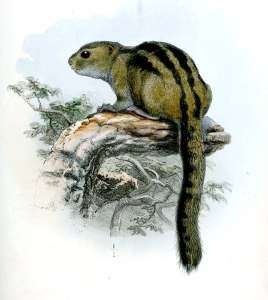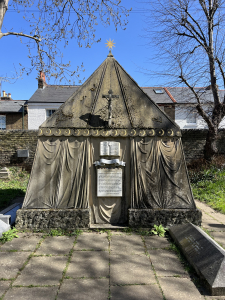Sir Richard Francis Burton

Richard Burton was born in Devon in 1821 into a middle ranking military family. His early life was spent moving around, often travelling abroad and growing his knowledge of languages and cultures.
During his youth, Richard and his family briefly resided on Maids of Honour Row on Richmond Green, where he attended school.
Following a short stint at Oxford University, Richard’s career in the East India Company’s army, the British Empire’s consular service, and his relationship with the Royal Geographical Society (RGS) enabled him to travel across the world.
He married Lady Isabel Burton in 1861 and the couple travelled the world together. They now lie side by side inside the Burton Mausoleum in Mortlake.
The Hajj
Richard Burton rose to fame after publishing his narrative of performing the Hajj, the Muslim pilgrimage. In 1853, he travelled to Makkah, a place forbidden to non-Muslims. He disguised himself as a dervish (Muslim ascetic) named Abdullah, to avoid detection.
The trip was supported by the RGS who hoped Richard would return with valuable information about Arabian trade routes.
Richard was not the first non-Muslim, nor European, to perform the Hajj, but the popularity of his book meant that his narrative became the dominant understanding of this sacred journey. Like many of his books, his work continues to influence popular perceptions of Muslims today. He promoted attitudes and language that was generally accepted at the time; however, he was not immune to contemporary criticism.
This act of deception was one of several that Richard undertook during his lifetime in order to enter places and spaces usually inaccessible to non-Muslims or Europeans. This approach made him a complicated and controversial figure in the nineteenth century and today. His works remain useful as rare historical accounts, however, his methods of obtaining them would be considered unethical today.
His account portrayed him as a daring and brave adventurer, a character he would build up over the course of his career. He created an air of mystery and danger about himself. In 1878, the Burtons met Bram Stoker, author of Dracula, and he wrote this description of Richard:

“The man riveted my attention. He was dark, and forceful, and masterful, and ruthless. I have never seen so iron a countenance… The predominant characteristics were the darkness of the face – the desert burning; the strong mouth and nose, and jaw and forehead – the latter somewhat bold – and the strong, deep, resonant voice. My first impression of the man as of steel was consolidated and enhanced.”
– Bram Stoker, Personal Reminiscences of Henry Irving (1906)

Journey to the Source of the Nile
Richard is generally most remembered for his journey to locate the source of the River Nile, another trip funded by the RGS.
In 1857, Richard Burton, John Hanning Speke and their entourage including 132 porters embarked on their expedition to the African Great Lakes. One of their party was Sidi Mubarak Bombay, a waYao explorer from the border of Tanzania and Mozambique. Bombay was enslaved at 12 years old and taken to Gujarat. Freed after the death of his enslaver, Bombay returned to East Africa where he met Speke. Bombay went on to participate in many expeditions across Africa with many leading European explorers such as Burton, Henry Morton Stanley. Burton described him as “the gem of the party”.
A disagreement about which lake was the true source escalated into a public dispute between Burton and Speke. Speke died suddenly in a hunting accident shortly before he was due to debate Richard at the British Association for the Advancement of Science in 1864.
The aftermath of the expedition and Speke’s untimely death had an enduring negative effect on Richard’s reputation.
Scholarship
Richard’s proficiency with languages and dialects allowed him to establish a career publishing translations of intriguing eastern texts. He reportedly spoke 29 languages and dialects including Gujrati, Punjabi and Marathi, and translated key texts including the One Thousand Nights and a Night (Arabian Nights) (1885), The Perfumed Garden (1886) and the Kama Sutra (1883).
In some cases, Richard did not translate from the original language and has been accused of altering some of the text’s intended meanings.
Alongside languages, Richard had a deep fascination with religion. He claimed to have converted to Islam, and practised Hinduism and Sikhism at various points in his life. He also studied several other religions including Buddhism and Mormonism.
When Richard held the position of Consul at Fernando Po (now Bioko), an island off the coast of West Africa, he collected a variety of specimens for the Zoological Society of London. In 1862, a number of animals were presented to the society including Sciurus Isabella or Lady Burton’s rope squirrel found in the Cameroon Mountains. Professor Busk stated: “I have great pleasure in naming this beautiful new species after Mrs. Isabel burton, – her husband, the discoverer of it, having requested that any novelty that might be in the list should be so named”.
Richard’s discoveries in flora and fauna continue to assist scholarly research today. In fact, Royal Botanic Gardens Kew still hold samples of flora Richard sent from north-western Arabia.




The Burton Mausoleum
An important goal for Richard was to gain the role of Consul at Damascus and to fulfil his and Isabel’s dream of a life in Syria. Their time spent in Damascus and travelling through the Syrian desert was so important to them, they decided their final resting place should be in the shape of a Bedouin tent.
Richard was recalled from Damascus in 1871 but they brought objects and influences from their time there through their lives. A description of their home in Trieste shows how this influence was used to furnish their home there:
“Captain and Mrs. Burton are well lodged on a flat composed of ten rooms, separated by a corridor adorned with a picture of our Saviour, a statuette of St. Joseph… and a Madonna… Thus far the belongings are all of the Cross [Catholic]; but no sooner are we landed in the little drawing-rooms than signs of the Crescent [Islam] appear.
Small but artistically arranged… rooms… are bright with Oriental hangings, with trays and dishes of gold and silver… chibouques with great amber mouthpieces, and all kinds of Eastern treasures mingled with family souvenirs. There is no carpet, but a Bedouin rug occupies the middle of the floor, and vies in brilliancy of colour with Persian enamels and bits of good old china.” – World, Celebrity at Home, Captain R. F. Burton at Trieste, 1877
Inside the Burton Mausoleum is a similarly rich collection of objects of Middle Eastern origin as well as Catholic motifs.
Learn more about the History of the Burton Mausoleum here.